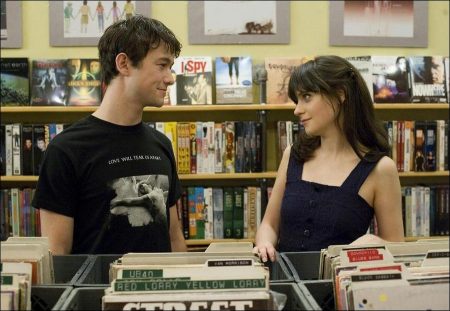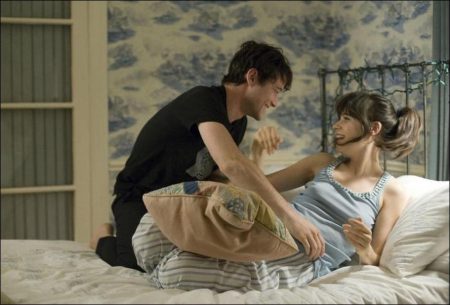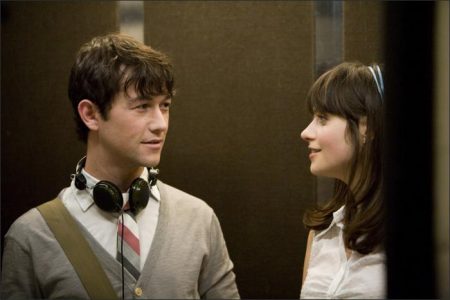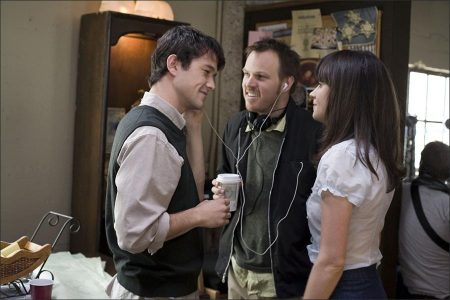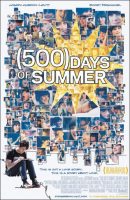The Beginnings of Summer: Penning a Postmodern Love Story
“For all intents and purposes, Summer Finn – just another girl. Except she wasn’t.” — The Narrator
500 Days of Summer began in angst. It was sparked by two young screenwriters – one single and recovering from a badly bruised heart, the other in a long-term relationship — reminiscing over romances that could have been, that maybe should have been, but somehow just… weren’t. Almost everyone has had one and, in an age when everything seems to happen faster and more intensely, they seem to be ever more common. So how, wondered Scott Neustadter and Michael Weber, does a young romantic survive such a reality? And how could today’s version of romantic idealism be portrayed on the screen in a way it’s never really been seen before?
“There are certain topics that romantic comedies always hint around and never really tackle directly,” says Neustadter. “Questions such as: is there really such a thing as `the one?’ And, if there is, what happens if you lose her? What do you do now? Can you still believe in love? Do your beliefs about love change? These were the questions Weber and I wanted to write about even though we don’t quite have the answers.”
Thus was born the character of Tom Hansen, a guy who believes madly, passionately, even unreasonably in the mystery and power of love, and the woman who doesn’t – Tom’s romantic muse, total obsession and the frustratingly non-committal, destiny-denying bane of his existence: Summer. But it wasn’t just Tom that the screenwriters were interested in; it was the inner workings of his memory, as he looks back on just what really happened between him and Summer.
“The idea we had for the screenplay was sort of a romantic comedy meets MEMENTO. We wanted to follow a guy sifting through the memories of a relationship, moving backwards and forwards through time as he starts to see things he might not have seen while he was going through it,” explains Neustadter. “You watch him gaining perspective and learning something about himself and about love. Tom realizes he is someone who is in love with the idea of love and that’s why his story becomes a very hopeful one. He sees something about the nature of love. It’s not your conventional romantic comedy, but it is a very romantic story.”
From the beginning Neustadter and Weber chafed against the perennially cutesy, sentimental and unexamined conventions of romantic comedies — and searched for a truer way to tell Tom’s story of the romance that put his heart through a mix-master, only to leave him with an even stronger, if more mature, belief in love. “We threw away all the rules and looked at alternative structures,” explains Neustadter. “We followed every single idea no matter how crazy it seemed, from the way people are transported by a song to how they drown their sorrows in a movie. Anything that was in Tom’s mind and memory was fair game.”
Continues Weber: “Writing this movie became an incredibly creative experience, because we gave ourselves so much freedom and we were constantly exploring how people’s emotions and relationships are tied up in the culture all around us – in the songs, movies, books, television and art by which we define our identities.”
Neustadter and Weber also freely played with time, moving ahead and then back-pedaling through Tom and Summer’s relationship at will. “Jumbling the chronology of the movie was a lot of fun for us,” continues Weber, “but there was also a method to our madness. By pulling out certain moments on their way up and on their way down, you see things you might not otherwise notice and from a new persepective. And, if you think about it, that’s how memory really works, where something will trigger your mind to think of an amazing, wonderful moment and then that will trigger the memory of a bad moment and then comes a revelation of how they were all connected.”
Most of all, the priority was on keeping the whole process as emotionally honest as the two men could possibly withstand. “We’ve all been in the trenches of love, we’ve all gone through the highs and lows, so Scott and I felt that the only way to tell this story was to come at it from a completely real place,” says Weber. “It was pretty interesting for us because Scott was just going through a break-up and I was in a long-term, stable relationship, so we each brought a totally opposite perspective, living it and not living it, and I think that tension helped to bring out more of the comedy.”
Ultimately it was that thread of emotional honesty that drew a diverse team of talent to 500 DAYS OF SUMMER. Says producer Mason Novick, who also produced last year’s unconventional and widely acclaimed hit comedy Juno: “This is a story that doesn’t fit directly into any genre or label. It’s not your typical romantic comedy and it’s not your typical drama – it’s an intriguing, funny, fresh perspective on what modern relationships are really like. And it attracted just the right group of people to pull it all together.”
Novick was amazed to learn just how much of the playful, fast-paced screenplay was pulled straight from real life. “Of course, truth is often stranger than fiction,” he says. “Some of the scenes I thought had to have been imagined the writers told me, `no, no, that really happened.’ They were able to bring that quality of reality and put it together with their very unique view of the world and of becoming part of a couple.”
Adds producer Jessica Tuchinsky, who is partnered with producer Mark Waters (director of such films as Freaky Friday, Mean Girls and The Spiderwick Chronicles) in Watermark Pictures: “The two writers, Scott and Michael, are basically two Toms. They’ve grown up on the same songs, the same movies and they’ve felt the same fireworks when they’ve fallen in love as Tom in the movie and they put all of that into the script in a very clever way structurally.”
Producer Steven Wolfe (who brought the iconoclastic Polish Brothers to the fore with their directorial debut, Twin Falls, Idaho) notes that everyone who read the script realized it would need a very special touch: “It uses a multitude of storytelling devices, and it’s very complex in how it flashes backwards and forwards and uses these total fantasy moments and pulls all these different pieces together into a puzzle,” he says. “We knew it would need a director who could plan everything right down to the most minute detail.”
The search for a director with a vision that could stand up to the screenplay’s creativity led the filmmaking team to newcomer Marc Webb, who had cut his teeth on music videos and commercials and was in search of his first feature film. He quickly gave his own heart to 500 DAYS OF SUMMER. “When I first read the script, it was like Tom seeing Summer for the first time,” muses Webb. “Something clicked and I just knew this was the one.”
Like any man infatuated, it was a sense of mystery that drew him deeper in. “The first time I read it, I remember feeling something I couldn’t define,” Webb recalls. “When I went back and read it again, I realized there is a theme in the movie that is implicit, it’s not ever explicitly stated, but it’s that Tom finally is hit with the idea that happiness is found within. He sees that it isn’t in the big blue of eyes of the girl in the cubicle down the hall, even though she can be very beguiling and gets him thinking that she is what will bring him happiness. The truth is that you have to realize who you are and understand your own potential before you can really find true love. At the end of the day I felt this story was a very fun way to say something that had some meaning for me.”
Webb was also excited about the daring style of 500 DAYS OF SUMMER – and the writers were equally excited about him. “We didn’t know anything about Marc at first, but we had the most remarkable marriage of ideas with him,” says Neustadter. “All three of us very much wanted to make the same movie and that was exciting.”
The Many Moods of Summer: Casting The Film
“Settle. Don’t get too excited. She’s just a girl. Wants to keep it casual.
Which is why she’s in your bed right now. Without clothes. That’s casual, right?” — Tom
In 500 DAYS OF SUMMER, the typical “he said, she said” POV of romantic comedies is abandoned entirely in favor of the “he said” approach. Everything that is seen on screen comes straight from the love- addled, mood-clouded mind of Tom Hansen, a man who writes pithy romantic sayings for others yet can’t seem to communicate the overpowering depth of his own feelings to the only women who matters to him: the elusive Summer.
Since all the other characters are ultimately viewed through Tom’s subjective experience, casting Tom was central to the film’s entire foundation. Director Marc Webb enthusiastically chose Joseph Gordon-Levitt, the young but already remarkably diverse actor who has distinguished himself over the last few years as uncategorizable and fascinating to watch in such films as Stop-Loss, Miracle at St. Anna, The Lookout and Manic.
“Joe is so very intelligent and he understood every line of this story and of Tom’s entire emotional arc,” says Webb. “At the same time, he was very inquisitive, asking a lot of great questions. It’s easy to forget that Joe started his career on a sit-com, but he also has a very solid basis in the craft of comedy that he brings to Tom,” says Webb. “He has an almost scientific approach to playing the straight man — he finds ways to be very funny while still bringing genuine emotion to every scene.”
Gordon-Levitt loved the idea of telling a love story from the rarely cracked male interior point of view. “I liked that the story was written by two guys and is directed by a guy and they were all completely unapologetic about the idea that this story is from our perspective,” he says. “It doesn’t pretend to be an objective point of view. The entire story is completely subjective from Tom’s internal experience and it illuminates his experience of love. Love isn’t rational or logical or linear – and the film completely reflects that.”
He continues: “It’s a heartfelt cinematic experience that’s hilarious but doesn’t pander. It manages to be an authentic story about love without taking itself too seriously.”
As for what Tom discovers about love in the midst of Summer, Gordon-Levitt says: “I think Tom always thought love was like what he saw in the movies or heard in pop songs. He has a lot of preconceived notions of what love should be, instead of really living in the present tense and paying attention to what’s actually happening between him and Summer… which he only sees later.”
Naturally, Gordon-Levitt was able to bring some of his own experience to the role. “I’ve had my heart broken before, truly, truly, truly broken,” he confesses. “But when I look back at me in my broken-hearted phase it’s pretty hilarious, because it feels so much more extreme than it really is. One of the things I love about 500 DAYS OF SUMMER is that it doesn’t make light of what we go through in romances but it is honest about it and shows it for what it is, which is often profoundly funny.”
Another joy for Gordon-Levitt was reuniting with Zooey Deschanel, with whom he previously starred as two disturbed teenagers in the indie drama MANIC. “It was great to do something so completely different with her and to have fun every day,” he says. “500 DAYS is so whimsical and dreamlike and sweet – and it’s easy to feel like that when you’re with Zooey.”
Indeed, those qualities were precisely what led Marc Webb to cast the beguiling young actress, most recently seen in YES MAN with Jim Carrey, as Summer. “Zooey is just the perfect alt-ingénue,” Webb muses. “She is Summer in so many ways. She’s funny, she’s real, she’s very smart, she’s got the most beautiful eyes you’ve ever seen and she’s got a great sort of mercurial energy that makes her constantly compelling to watch.”
Deschanel was drawn to the challenge of playing the ideal inside a young romantic’s mind. “Summer is such an interesting character, because she’s really seen entirely from Tom’s perspective as this ideal woman, when she’s actually just a smart, interesting girl with her own problems,” she observes. “I was so excited when I read the script because it’s so rare to see a romantic comedy that’s really fresh and different. It felt like a new way of telling a story we think we’ve seen before.”
Working with Gordon-Levitt was also a draw. “Joe and I have known each other for many years and I feel completely comfortable with him,” she says. “I think he’s the perfect Tom because he’s sweet and adorable but he manages to communicate a kind of naiveté within all his charm.”
What happens between Tom and Summer doesn’t occur in a vacuum and it is Tom’s friends and family who are his sounding boards and advisers through out the relationship as he tries to make sense of his desire for Summer and her not-always-clear responses. His two best friends – his doctor friend Paul and co-worker McKenzie – struggle to uncloud Tom’s vision right from the get go. They are played by Matthew Gray Gubler, a young filmmaker and actor seen on CBS’ “Criminal Minds,” and Geoffrey Arend who has had memorable roles in such comedy hits as Super Troopers and Garden State.
“I see Paul and McKenzie as the kind of Good Angel and Bad Angel who are helping Tom to figure out what he’s doing,” says Gray Gubler. “Paul is more straight-laced and McKenzie is more rambunctious and so they’re giving Tom completely divergent advice. Paul has been married for years to a girl he met in preschool and McKenzie has maybe dated one girl in his entire life. So, unfortunately, his two Obi Wan Kenobi’s are on the socially inept side!”
Arend had a blast with the dynamic between Tom and McKenzie. “Tom is the eternal optimist, always waiting for Cinderella to sweep him off his feet and McKenzie is the pessimist who believes nothing is ever going to work, who believes true love is a myth,” Arend notes. “But no matter what McKenzie or Paul says, Tom still always goes his own way.”
Both actors were very intrigued by Marc Webb’s innovative approach to storytelling. “It’s a visual, mood-driven kind of storytelling that seems to get at what it feels like to be in love,” sums up Gray Gubler. “And I love that it doesn’t end on a cynical note.”
Adds Arend: “I haven’t encountered any story like this in recent memory that so closely gets at the clash between romance and reality. It busts through clichés and that’s always interesting.”
Providing perhaps Tom’s best source of advice is, unexpectedly, his 12 year-old sister Rachel who dispenses such pull-no-punches gems as “just cause some cute girl likes the same bizzaro crap you do doesn’t make her your soul-mate.” To play Rachel, Webb cast young Chloë Grace Moretz, who has been acting since age 5 and has had roles in such features as THE EYE and BOLT.
Tackling the brother/sister dynamic, Moretz says that she drew from plenty of real world experience. “I have four brothers of my own and they’re all older, and I’m the only girl, so I know that chemistry,” she says.
And, in spite of her age and relative inexperience in such matters, she was very clear on the uselessness of the state in which Tom finds himself. “When you’re with somebody who is wearing rose-colored glasses you can see things they can’t,” Moretz explains. “That’s how Rachel is with Tom. She sees things he doesn’t and she’s pretty fearless about speaking her mind.”
The Sounds of Summer: About the Music
“I’m not near drunk enough to sing in front of all these people.” — Tom
Nothing can capture the slap-happiness of infatuation or the agony of heartbreak in a matter of minutes like a pop song – and music was always key to the vision for 500 DAYS OF SUMMER. Even as they wrote the screenplay, Scott Neustadter and Michael Weber were weaving specific tunes from their own memories – from Lee Greenwood’s anthem “God Bless the USA” to a karaoke take on the Clash’s plaintive “Train in Vain” to the ubiquitous Hall & Oates’ ballad “You Make My Dreams Come True” — into the framework. Music is everywhere in the story; it’s what draws Tom and Summer together; it’s what fuels his ecstasy and charts his angst as he rides the roller coaster of their relationship; it’s even what they bicker about, engaging in whimsical debate over their favorite Beatles.
“When you’re falling in love or falling out of love, that’s what you do. You listen to a massive amount of music,” says Neustadter. “There’s always a soundtrack to any relationship and songs are a great way to express certain feelings that can’t be easily articulated.”
Once Marc Webb came on board, he too envisioned the narrative unfolding not just visually but aurally, through a wall of sound that would further reflect the mad intensity and wonder of Tom’s feelings – not to mention fantasies — about Summer. “Music is half of this movie and it’s a way to affect people on a pure gut level,” says Webb. “Coming from music videos, I’ve always been interested in how you apply images to music.”
Music supervisor Andrea Von Foerster, who has worked on such hit music-driven shows as “The O.C.” and “Grey’s Anatomy,” faced the challenge of securing the rights for songs that were important pieces to the final product – and finding additional songs, from classic and new artists, that would match Tom’s kaleidoscope of feelings.
Von Foerster notes that the film was a dream project for a music lover. “Everyone involved in this film has fantastic musical taste, starting with the writers who wrote in so many great songs right into the story,” she says. “That love of music has added another dimension to the storytelling.”
The Look of Summer: Designing Tom’s Worlds, Real and Fantasized
“Relationships are messy and feelings get hurt. Who needs all that? We’re young. We’re in one of the most beautiful cities on earth. I say let’s have as much fun as we can…” — Summer
The imagery of 500 DAYS OF SUMMER streams directly out of Tom’s inner experience of falling in love and fighting to stay in love when the going gets tough – and it runs the cinematic gamut from dream sequences to musical numbers to cartoon birds to odes to the melancholy of French films. As Marc Webb relates: “The idea was to create a complete world for Tom with its own space and time. We used a lot of different filmmaking tools and techniques, but we tried to avoid superficial gimmicks. The most important thing was always the emotional flow of the story.”
Webb collaborated closely with cinematographer Eric Steelberg, who also shot JUNO, frame by frame. “Marc’s aesthetic was to be very natural but to punctuate that naturalism with these fantastical moments that show his heightened feelings surrounding Summer,” Steelberg explains. “He also wanted to shoot Los Angeles in an original way and he showed me these really beautiful, tactile, moody color photographs of cities from the 50s and 60s and that was the style that he wanted to shoot in. For me, it was refreshing to work with a director who has such a strong sense of visual grammar and puts it as far forward as Marc does.”
“We were interested in using color in a way that feels meaningful,” says Webb. “Although we used a limited palette, we wanted it to still feel warm and inviting and artful.”
Webb’s idea to shoot Los Angeles as an iconic city of love like New York or Paris also greatly appealed to production designer Laura Fox. “We had an opportunity to create an unexpected view of Los Angeles,” says Fox. “It’s a city that can be very beautiful, romantic and exciting when you really look at the architectural details, and the buildings, and the history.”
Adds Webb: “We were pretty vigilant in avoiding the clean, sleek and modern and using locations like pre-war downtown and Korea Town and the karaoke bar where you get this feeling of a world that’s like a storybook left on the shelf – a little dog-eared, a little faded, but with lots of hope underneath.”
Fox found the whimsy of the story an inspiration throughout her set designs. “This production was a lot of fun for me because there’s this heightened reality to everything, so we were able to add twists to the real world, from Tom’s stylish downtown loft to the greeting card company which is housed in an old dance hall. We gave everything a contemporary feel but also kept a timeless feel by using things that could have been used 20 years ago and will still be used 20 years from now.”
Also going to town creatively was Hope Hanafin, the film’s costume designer, who used a similar mixture of the timeless, the stylish and the romantic to further evoke Tom’s world. Hanafin recalls Webb showing her photographs during their first meeting together that set the tone. “They were of contemporary subjects but had a feeling of being out of time. They had a monochromal quality and they were diffused enough that they had a sense of distance and romance,” she recalls. “That was our starting point – looking for images that live in the imagination because they’re not locked into any specific moment.”
To get to that feeling, Hanafin created the character’s costumes all in synch with each other, mixing and matching like a collage artist. She began with Tom, whose clothes shift with his emotions. She explains, “Tom is seen in more unkempt khakis and sweaters when he is at work where he’s not as emotionally invested but when he is out and about and has the chance to be himself, he has a hipper, younger look that references the Sixties and French cinema.”
She continues: “A lot of things play into his look and we were always looking at the interaction of his palette with all the other players so that things are either emphasizing or contradicting Tom’s mood. Tom is always the pivotal person in every composition.”
Indeed, Summer’s look emerges from Tom’s view of her as the ultimate object of his affection – hence her retro dresses, camisoles and hairstyles, that emphasize a distant memory of perfect femininity. But there was also something else that defined Summer… the color blue. Hanafin elaborates: “We saved the color blue just for Zooey’s character. Zooey has the most amazing blue eyes and there’s something magical about putting blue on her, or even putting blue behind her. No one else wears it except for one special moment… when the whole world turns blue.”
Those kinds of color-bursting moments were vital to Marc Webb’s vision for the film, but he also wanted them to be part and parcel of the storytelling. He summarizes: “I didn’t want this movie to be about spectacle, but to break away from conventions and be an emotionally engaging journey about people figuring out the place of passion in their lives. I wish I’d known about Tom and Summer when I was 18 – maybe it would have made my love life a little easier!”
(500) Days of Summer (2009)
Directed by: Marc Webb
Starring: Zooey Deschanel, Joseph Gordon-Levitt, Geoffrey Arend, Chloë Grace Moretz, Matthew Gray Gubler, Patricia Belcher, Rachel Boston, Minka Kelly, Ian Reed Kesler
Screenplay by: Scott Neustadter, Michael Weber
Production Design by: Laura Fox
Cinematography by: Eric Steelberg
Film Editing by: Alan Edward Bell
Costume Design by: Hope Hanafin
Set Decoration by: Jennifer Lukehart
Art Direction by: Charles Varga
Music by: Mychael Danna, Rob Simonsen
MPAA Rating: PG-13 for sexual material and language.
Distributed by: Fox Searchlight Pictures
Release Date: July 17, 2009
Visits: 217
